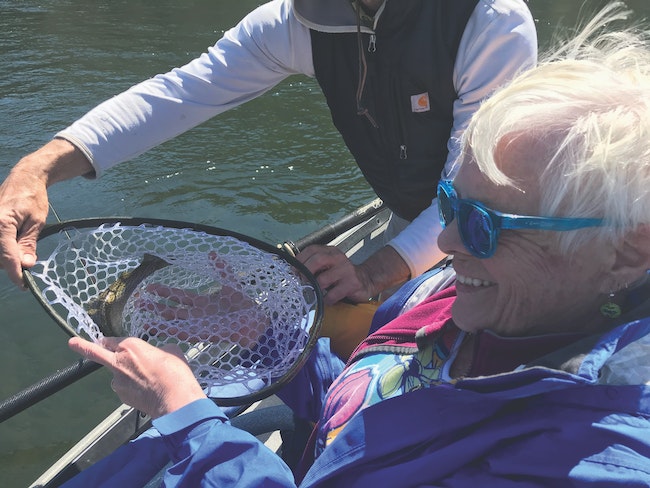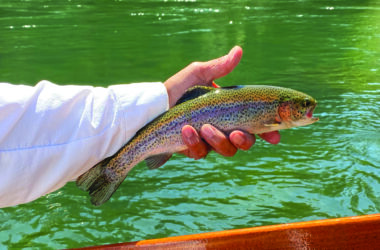 FRANK ARMENDARIZ
FRANK ARMENDARIZ
Another one in the net for Tami Armendariz, who also tied the flies we used for our day of fly fishing for wild trout on the McKenzie. All the fish were released unharmed.
It has been a wonderful spring, with mild sunny weather and little rain. In fact it has been one of the driest Aprils in recent history, giving a lot of Oregonians a chance to shake off the effects of an extended “cabin fever” that in the light of the seemingly endless days of shutdowns and stay-at-home recommendations took on a new meaning last year.
Spring break crowds across our region were relatively heavy and likely a good indicator of the amount of pentup demand for recreational opportunities. Demand that will surely crescendo in late June and remain at that pitch throughout the summer. If your summer fishing plans are anchored by a stay at a federal, state or county campground, most require a reservation and now is the time to make those plans.
I speak with Greg Taylor every spring. Taylor is the managing biologist for the Army Corps of Engineers, Willamette Valley Project. He monitors the Army Corps’ 13 reservoirs in the Willamette Valley and makes recommendations on the amount of discharge to protect migrating salmon and steelhead that return to the base of their flood control dams.
The mild, dry weather that has drawn so many people to the outdoors in recent days has left most of the valley’s reservoirs in need of a few days of heavy rain. On average, the 13 reservoirs in Taylor’s district are 25-50% lower than usual. The regular amount of rain would generally have the valley’s dams 80-85% full by mid-April and completely full by early May.
Here in the southern valley things are not too bad. Fall Creek and Dorena are only about 10% below the average pool height for mid-April and both were recently planted with rainbow trout. Last winter’s storms pushed more precipitation northward and the snowpack is heavier in the central and northern Oregon Cascades. So further up the valley in the Santiam River basin, Detroit, Foster and Green Petter reservoirs are also in good shape. Detroit has a wonderful Kokanee fishery that is underway and all three were recently planted with rainbow trout.
Conditions look to be good throughout the spring and into early summer. But without more rain in the next few weeks, things could begin to become a little dicey by mid- and late-summer on these popular water bodies.
***
There’s good news for Oregon coho salmon anglers: the production in the ocean has been consistent the past several seasons and anglers will be allowed to harvest more of the silvery salmon this season. In the Cape Falcon to Humbug Mountain beginning June 12-Aug. 28 the allowable harvest for all hatchery salmon went from 22,000 to 120,000. A “any coho” (wild or hatchery) season was also announced. Beginning on Sept. 10-22, then each Friday, Saturday and Sunday to Sept. 30 – or until a quota of 14,000 coho are caught. South of Humbug Mountain it’s a hatchery coho show only again this season. Beginning June 12 and running through Aug. 15 – or until a quota of 120,000 hatchery coho has been met. In general across both zones you are allowed two salmon per day, only one of which can be a chinook. But always check the regulations specific to where you plan to fish. Ocean chinook season is open but reports have been thin. I also expect an update from the ODFW on fall chinook fishing at any time, so stay tuned.
***
I fly fished a section of the lower McKenzie River last week with my good friend and fellow river guide Wade Hanel. ODFW will be cranking up its yearly fish stocking program next week. Motivated by the stellar weather, we took the opportunity to do a “pre-float.” Undamaged by last fall’s fire, the McKenzie below Leaburg Dam is still about how we all remember it. All the regular parks and boat landings are open to the public, including the much-improved Hendricks Wayside & Park, where the parking capacity was greatly expanded and the boat landing was realigned, making it a lot easier to stage your drift boat, negotiate the ramp and launch. You will need an annual Lane County park pass to park in the lot or visit the self-serve day-use kiosk located in the park.
The day we fished was just an exceptional spring day with temperatures reaching 60 and only a slight upriver breeze. We launched from Deerhorn Park at about 10:30 for a float down to the EWEB takeout at the head of the Walterville canal. It’s a short trip but good for about three or four hours of fishing and perfect for an after-work float. Water temperature was 50 and likely because of the lack of rain the river was only 1.5 feet on the Vida gage, a river level consistent with flows more typical of late July or August.
Not all bad news, the lower water levels bunch the fish up and we found a biting fish in just about every likely section of holding water as we floated along, and we released several very nice wild rainbows in the few hours we fished that day. A couple came to my dry fly, a #10 elk hair caddis but the hot fly combo was a #8 dark brown woolly buggers with a prince nymph dropper that my wife Tami was dead-drifting along the bottom of the runs as we floated in Wade’s drift boat. In the bright sunshine I rate our experience as fair to good. A little cloud cover could have made the catching exceptional. Hanel is a solid angler, a skilled boatman and a great host. With Hanel on the oars it was a real pleasure to be in the front of the drift boat for a change; I could easily get used to it.
Finally, the bass boat came out of storage for the season this week and I’ll have an in-depth look soon at fishing for a species whose popularity grows every year.
Email:








